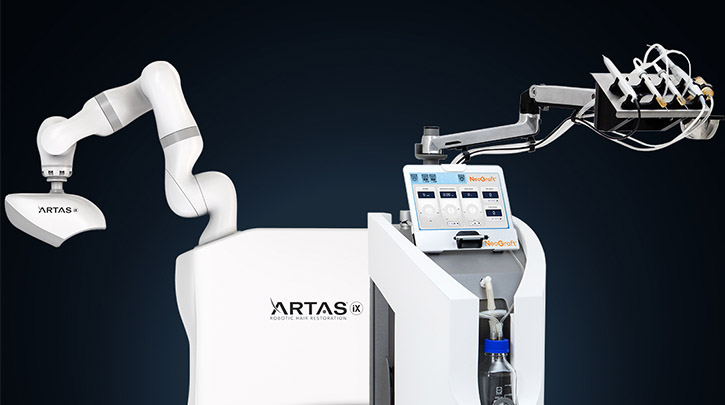Hair loss is an aesthetic concern that affects an average of more than 80 million Americans at any given time. While the majority do tend to be male, female hair loss is more common than your prospective patients believe. While many hair loss patients are used to seeing male celebrities sporting little to no hair, female celebrities are often seen flaunting long, luscious locks with the occasional shorter style that shows no sign of thinning. This can make the experience of hair loss feel rather isolating for female patients—a perception that contrasts the estimated 30 million U.S. women who are experiencing hair loss for a variety of reasons.
To better serve these prospective patients, it’s important to understand female hair loss, how it affects these patients, and how your clinic can better reach this valuable patient base and deliver the solutions they want.
How Female Patients Experience Hair Loss
According to one study by the American Academy of Dermatology, 40% of women will experience noticeable hair loss by the age of 40, the reasons for which may vary. Female hair loss can be triggered by a range of factors, from short-term events like excess stress to long-term factors like postpartum hormonal imbalances, or during menopause. Diet and medications can cause hair thinning as well, alongside underlying health conditions. Hairstyles that pull hair too tight and cause trauma to the hair follicles can also lead to hair loss, thinning, or a receding hairline in some female patients. However, among all these factors, genetics play the most significant role by far in determining who is more likely to experience female pattern hair loss or thinning.
Genetic female pattern hair loss (androgenetic alopecia) appears as the thinning of hair follicles generally along the sides or top of the head but differs in some aspects to male pattern baldness. While there are several genes that may play a role, researchers in the Netherlands have most significantly linked a variation in an androgen receptor (AR) gene on the X chromosome to female pattern baldness, with the gene itself amplifying the androgen hormone’s negative effects on hair health. Further still, another study has linked the inherited APCDD1 gene to miniaturization of hair follicles, a process that causes hair follicles to shrink in size, become thinner, more fragile, and easily breakable.
Whatever the cause, understanding the cause(s) behind a female patient’s hair loss is imperative to best evaluate and select the best course of treatment for each patient.
Female Hair Loss Solutions
The hair loss solutions market is large and complex, but it’s important to note that it represents a broad range of patients. There isn’t any one approach that perfectly fits every patient, particularly with female hair loss and thinning, the causes for which vary widely. A thorough evaluation is needed to first determine the cause of female hair loss or thinning, which will then inform your clinic on what option may be best for each patient. The following are some hair loss solutions you may suggest, alongside one effective and customizable hair transplantation option.
Minoxidil and Prescription Medications
Used for some time to treat male pattern baldness, minoxidil has more recently been approved for treating female hair loss. It is a vasodilator and topical medication used to help spur hair growth, and the widening of blood vessels that help to deliver more oxygen and nutrients to hair follicles. This encourages the follicles progress through the telogen (resting) phase and into a new anagen (growth) phase. To maintain hair regrowth, minoxidil must be used frequently and is not considered an ideal solution for larger areas of hair loss or thinning. While there are other prescription medications that may help to halt female hair loss, most of these medications were not specifically developed to treat it. As with minoxidil, all medications prescribed for the off-label use of hair loss prevention or hair regrowth must be continuously taken or hair loss will return.
At-Home Laser Treatments
Low-level laser devices have been approved by the FDA for use in treating hair loss at home. Available as laser combs, helmets, or other formats, at-home laser treatments for hair restoration deliver a low-level laser light deep within the targeted hair follicles. This helps to stimulate new hair growth for the gradual appearance of thicker hair. As with prescription and topical treatments, these at-home laser hair restoration devices must be used on a continuous basis to sustain this new hair growth.
Platelet-Rich Plasma (PRP) Therapy
Early research so far suggests that platelet-rich plasma (PRP) therapy may help to stimulate hair cells to grow while delivering valuable nutrients to resting hair follicles to better restore hair strength and health. Most commonly used in facial treatments, PRP therapy utilizes the patient’s own blood plasma to stimulate cellular activity and renewal. Blood contains two main components: red blood cells and plasma. Plasma may be further broken down into white blood cells and platelets. Rich in growth factors, it’s the platelets that act as a messenger to dormant hair follicles, kicking them out of their telogen phase and spurring new hair growth. PRP therapy can be used alone, though one study notes it may help to boost the survivability of transplanted hair follicles when used as a follow-up treatment to an initial hair transplant procedure.
FUE Transplantation
A more recently developed hair transplantation technique, follicular unit extraction (FUE) is an increasingly popular hair restoration option, with the International Society of Hair Restoration Surgery (ISHRS) reporting 53% of all hair transplant procedures performed in 2017 used the FUE method. FUE stands in contrast to the follicular unit transplant (FUT) technique that is more invasive in its method of harvesting donor follicles as a strip removed from the sides or back of the head, often leaving a linear scar following treatment. In contrast, the NeoGraft hair restoration device, which uses the FUE method, utilizes gentle suction and very small circular punches of less than one millimeter to gently and precisely extract donor follicles in naturally-occurring groups. These groups of hair follicles are then sorted by how many hair follicles occur in each (usually one to three follicles). Using a dedicated implantation handpiece, follicles are implanted in patterns that suit the patient’s natural hairline. Hair density in the patient’s donor site is less affected because donor follicles are removed in small groups, versus in a strip. The FUE method leaves no linear scarring, is minimally invasive for patients, and offers a rapid recovery with less downtime as compared to FUT.
Case Study with NeoGraft for Female Hair Loss
For many women experiencing hair thinning, over-the-counter options tend to be their first response alongside styling hair to hide any thinning or bald patches. For the most part, hair loss solutions are marketed to men, so female patients may feel at a disadvantage when searching for someone to turn to for advice. Without clear marketing and there still being a stigma surrounding female hair loss, it can be difficult for prospective patients to know that there are other options available. One patient in particular named Jessi shared her journey of having tried several over-the-counter options to hide her hair loss prior to a friend recommending that she explore hair transplantation with NeoGraft.
“I was the girl who always had long, curly hair. As I got older, I got married and had my first son. I started experiencing thinning hair then. Three years later, I had my second son. Like a lot of moms, I lost my hair while nursing. For most women, it grows back, but after the second kid, the bald spot remained,” Jessi recalls. “Even though half of women experience hair loss, hardly anyone talks about it.” Jess notes that she tried several solutions herself before almost losing hope. “I tried vitamins, shampoos, spray fibers—all of that stuff only helps the hair you have. It doesn’t grow new hair.” That’s when her friend recommended she learn more about NeoGraft®.
Six months post-procedure, Jessi started noticing little hairs growing. At 18 months, she booked her first hair appointment with her stylist following her NeoGraft® procedure and entered with less nervousness. “Now that my hair is all grown, I feel like I can do any hairstyle. People are telling me how awesome and full my hair looks,” notes Jessi.
Interested in learning more about the benefits of NeoGraft® or how you can better launch your own successful hair restoration business specializing in female hair loss solutions? Contact an expert today using the button below.
Practice Enhancement Tips





